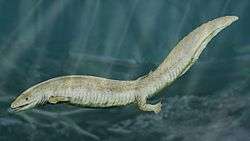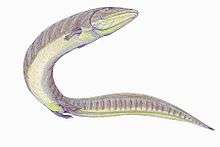Embolomeri
| Embolomeres Temporal range: Mississippian - Early Permian, 330–280 Ma Possible descendant taxon Chroniosuchia survives to the Late Triassic (Carnian) | |
|---|---|
 | |
| Restoration of Archeria from the Lower Permian of Texas. | |
| Scientific classification | |
| Kingdom: | Animalia |
| Phylum: | Chordata |
| Clade: | Reptiliomorpha |
| Clade: | Anthracosauria |
| Order: | †Embolomeri Cope, 1885 |
| Subgroups | |

Embolomeri is an order of tetrapods or stem-tetrapods, possibly members of Reptiliomorpha. Embolomeres first evolved from reptile-like amphibians in the Early Carboniferous (Mississippian). They were strongly specialized semiaquatic predators with long bodies for eel-like undulating swimming. Embolomeres are characterized by their vertebral centra, which are formed by two cylindrical segments, the pleurocentrum at the rear and intercentrum at the front. These segments are equal in size. Most other tetrapods have pleurocentra and intercentra which are drastically different in size and shape.[1]
Embolomeres were among the earliest large carnivorous tetrapods, with members such as the crocodilian-like Proterogyrinus appearing in the mid-Carboniferous period. However, they declined in diversity during the Permian period, although the most common embolomere known, Archeria, did live during this time. Embolomeres likely went extinct shortly after the time of Archeria, but their possible descendant taxa the chroniosuchians survived the Permian-Triassic extinction event that wiped out around 90% of all life on Earth.
The order Embolomeri was first named by Edward Drinker Cope in 1884 during his revision of "batrachian" (amphibian) evolution. Embolomeri was differentiated from several other newly named amphibian orders, such as "Rachitomi", by the presence of intercentra and pleurocentra of the same size and shape, that being large cylinders. At the time, embolomere fossils were uncommon, so Cope could only identify "cricotids" such as Cricotus as possessing embolomerous vertebrae.[1] The genus name "Cricotus" is dubious, as it has been used by Cope to refer to embolomere fossils spanning anywhere between mid-Pennsylvanian deposits of Illinois and the Permian red beds of Texas. Most paleontologists now refer the red bed "Cricotus" specimens to the genus Archeria.[2]
Classification
Like most early tetrapod or stem-tetrapod groups, the phylogenetic position of embolomeres is controversial. For much of the later 20th century, they were placed in the group Anthracosauria, a collection of tetrapods which resembled the amphibians biologically but were probably the ancestors of amniotes (reptiles and synapsids) rather than modern lissamphibians. Lissamphibians are often considered to be descendants of the temnospondyls, an entirely different group of crocodile-like amphibious tetrapods.[3]
Anthracosauria is sometimes considered synonymous with Embolomeri, and the group's namesake, Anthracosaurus, is an embolomere. However, other authors use the term "Anthracosauria" in reference to a broader group including embolomeres in combination with various other reptile-like amphibians (reptiliomorphs). Many studies conducted since the 1990s have also placed the group Lepospondyli as closer to amniotes than embolomeres were. Lepospondyls are a particularly unusual group of tetrapods, with some members (i.e. brachystelechids) very similar to lissamphibians and others (i.e. tuditanids) very similar to amniotes. If lepospondyls are both close relatives of amniotes and the ancestors of modern amphibians, then that means that crown-Tetrapoda (descendants of the common ancestor to all living tetrapods) is a much more restricted group than previously assumed. In this situation, various traditional orders of Tetrapoda such as Embolomeri and Temnospondyli actually would qualify as stem-tetrapods due to having evolved prior to the split between modern amphibians and amniotes.[4]
On the other hand, if temnospondyls are the descendants of modern amphibians, then embolomeres would likely be reptiliomorphs, part of Tetrapoda.[3] However, even this classification is not stable, as some analyses have found embolomeres to be more basal than temnospondyls.[5]
Below is a cladogram from Ruta et al. (2003):[3]
| Tetrapoda |
| |||||||||||||||||||||||||||||||||||||||||||||||||||||||||||||||||||||||||||||||||
Gallery
 Eoherpeton, a basal embolomere
Eoherpeton, a basal embolomere


 Skeletal reconstruction of Diplovertebron, an eogyrinid
Skeletal reconstruction of Diplovertebron, an eogyrinid Skeletal reconstruction of Eogyrinus
Skeletal reconstruction of Eogyrinus
)_(18159680495).jpg)
References
- 1 2 Cope, E.D. (January 1884). "The Batrachia of the Permian Period of North America". The American Naturalist. 18: 26–39.
- ↑ Romer, Alfred Sherwood (11 January 1957). "The Appendicular Skeleton of the Permian Embolomerous Amphibian Archeria" (PDF). Contributions from the Museum of Paleontology. 13 (5): 105–159.
- 1 2 3 Marcello Ruta, Michael I. Coates and Donald L. J. Quicke (2003). "Early tetrapod relationships revisited" (PDF). Biological Reviews. 78 (2): 251–345. doi:10.1017/S1464793102006103. PMID 12803423.
- ↑ Laurin, M.; Reisz, R.R. (1999). "A new study of Solenodonsaurus janenschi, and a reconsideration of amniote origins and stegocephalian evolution". Canadian Journal of Earth Sciences. 36 (8): 1239–1255. doi:10.1139/e99-036.
- ↑ Clack, J. A. (July 2002). "An early tetrapod from 'Romer's Gap'". Nature. 418 (6893): 72–76. doi:10.1038/nature00824. ISSN 0028-0836.





